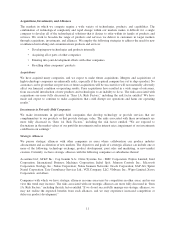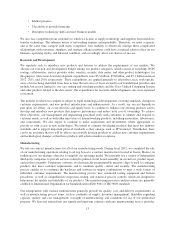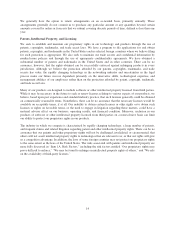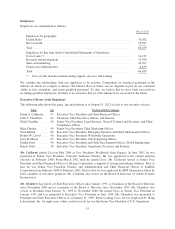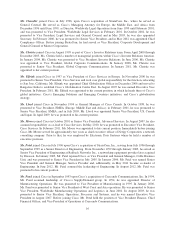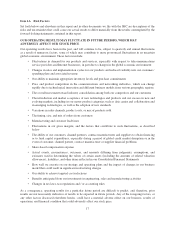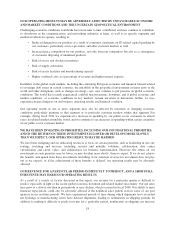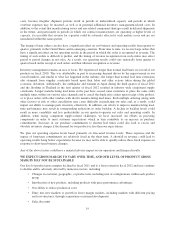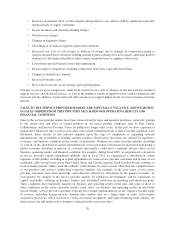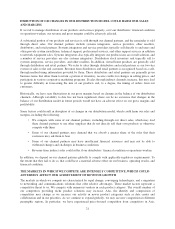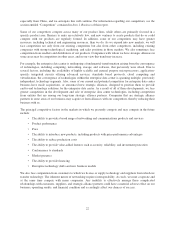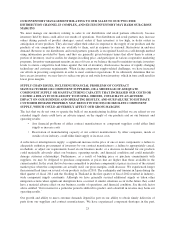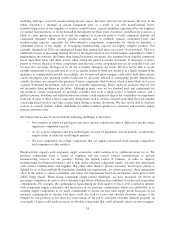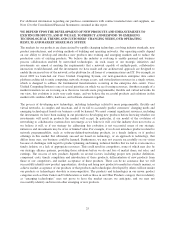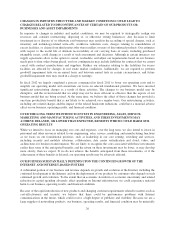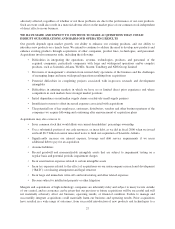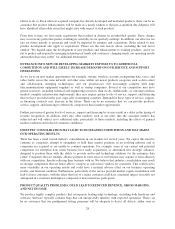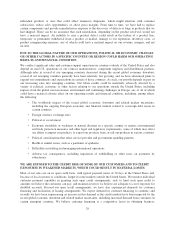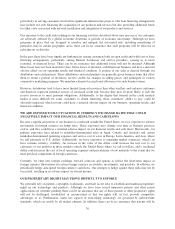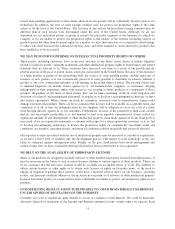Cisco 2012 Annual Report Download - page 29
Download and view the complete annual report
Please find page 29 of the 2012 Cisco annual report below. You can navigate through the pages in the report by either clicking on the pages listed below, or by using the keyword search tool below to find specific information within the annual report.DISRUPTION OF OR CHANGES IN OUR DISTRIBUTION MODEL COULD HARM OUR SALES
AND MARGINS
If we fail to manage distribution of our products and services properly, or if our distributors’ financial condition
or operations weaken, our revenue and gross margins could be adversely affected.
A substantial portion of our products and services is sold through our channel partners, and the remainder is sold
through direct sales. Our channel partners include systems integrators, service providers, other resellers,
distributors, and retail partners. Systems integrators and service providers typically sell directly to end users and
often provide system installation, technical support, professional services, and other support services in addition
to network equipment sales. Systems integrators also typically integrate our products into an overall solution, and
a number of service providers are also systems integrators. Distributors stock inventory and typically sell to
systems integrators, service providers, and other resellers. In addition, virtual home products are generally sold
through distributors and retail partners. We refer to sales through distributors and retail partners as our two-tier
system of sales to the end customer. Revenue from distributors and retail partners is recognized based on a sell-
through method using information provided by them. These distributors and retail partners are generally given
business terms that allow them to return a portion of inventory, receive credits for changes in selling prices, and
participate in various cooperative marketing programs. If sales through indirect channels increase, this may lead
to greater difficulty in forecasting the mix of our products and, to a degree, the timing of orders from our
customers.
Historically, we have seen fluctuations in our gross margins based on changes in the balance of our distribution
channels. Although variability to date has not been significant, there can be no assurance that changes in the
balance of our distribution model in future periods would not have an adverse effect on our gross margins and
profitability.
Some factors could result in disruption of or changes in our distribution model, which could harm our sales and
margins, including the following:
• We compete with some of our channel partners, including through our direct sales, which may lead
these channel partners to use other suppliers that do not directly sell their own products or otherwise
compete with them
• Some of our channel partners may demand that we absorb a greater share of the risks that their
customers may ask them to bear
• Some of our channel partners may have insufficient financial resources and may not be able to
withstand changes and challenges in business conditions
• Revenue from indirect sales could suffer if our distributors’ financial condition or operations weaken
In addition, we depend on our channel partners globally to comply with applicable regulatory requirements. To
the extent that they fail to do so, that could have a material adverse effect on our business, operating results, and
financial condition.
THE MARKETS IN WHICH WE COMPETE ARE INTENSELY COMPETITIVE, WHICH COULD
ADVERSELY AFFECT OUR ACHIEVEMENT OF REVENUE GROWTH
The markets in which we compete are characterized by rapid change, converging technologies, and a migration
to networking and communications solutions that offer relative advantages. These market factors represent a
competitive threat to us. We compete with numerous vendors in each product category. The overall number of
our competitors providing niche product solutions may increase. Also, the identity and composition of
competitors may change as we increase our activity in newer product categories such as data center and
collaboration and in our priorities. As we continue to expand globally, we may see new competition in different
geographic regions. In particular, we have experienced price-focused competition from competitors in Asia,
21


